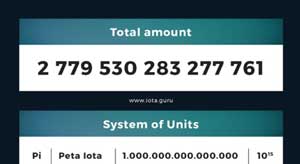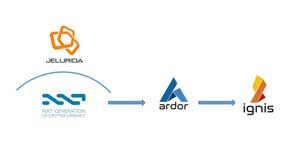
IOTA is a public distributed ledger technology that instead of using a blockchain, uses a tangle of blocks. The diagram below shows how this tangle of block is usually represented.

Taking this one step further, these blocks only have one transaction within so infact, it’s not really a tangle of blocks but a tangle of transactions. Hence IOTA quotes “As such it has no Blocks, no Chain and also no Miners.”
Wait, no miners? How are transactions confirmed? How is consensus achieved? Each transaction that is made on the network has to confirm 2 previous random transactions in a process called “tip selection”. This effectively means the users are the miners and this removes the power struggle that is seen in Bitcoin where different parties are motivated by different factors leading to lots of infighting and disagreements. This also means there is no need for transaction fees.
Let’s take a step back and learn about the name.
What does IOTA mean?
IOTA is the 9th letter of the Greek alphabet. It means a small or tiny amount. As an acronym, IOT represents the Internet Of Things. The “A” could mean Architecture, Array, Application, take your pick.
Because IOT devices are due to explode into the billions around low powered sensor devices for machine to machine communications, IOTA intends to facility these transactions with a very small amount of IOTA tokens. Clever. This then leads to the question, how many IOTA tokens are there?
IOTA Token Supply
Initially there were 999,999,999 tokens created. That was then revised to 2,779,530,283,277,761 which is a really big number. This is 2.7 Peta IOTAs. It may sound a lot but bitcoin has 2.1 Peta satoshis. (21 million + 8 decimal places).
The reason for the 2.7 Quadrillion comes from the calculation (3^33 – 1) / 2 which is optimized for ternary computing. Ternary meaning there are 3 states -1, 0 and 1 instead of binary where there are 2 states.
All these coins have been created and distributed as you can see at coinmarketcap.com.
Token sale
The original token sale took place on 25 November 2015 where around 1191 btc were raised which at the then price of $442 USD gave $526,481 USD. There is a breakdown here.
DAG
When reading about IOTA you’ll come across a term called DAG. It’s a non-trivial concept that understanding the acronym won’t even shed any light. It stands for Direct Acyclic Graph. See, I told you. Essentially a direct acyclic graph is a way to represent moving or hopping through information down a one way street where you don’t encounter the same info or data twice. Direct can be thought of as going in one direction. Acyclic meaning it is non circular so you don’t end up back where you started and Graph is a general term used to allow one to represent or visual the data.
This relates to IOTA because from the diagram at the very top, transactions are traversed, directed from right to left, it doesn’t loop back around in any way, acyclic, and it can be thought of as a graph.
Here is a great podcast on IOTA between co-founder of IOTA David Sonstebo and Arthur Falls, a podcaster from ConsenSys. It’s 52 minutes but well worth the listen.
Summary
IOTA is a relatively new concept where it does away with placing a group of transactions into a block. Each transaction connects to other transactions forming this large tangle of transactions. This is because for machine to machine communication, the blockchain provided so many constraints in it’s current form, IOTA had to think out of the box.
What is interesting to note is that tangle was presented in 2015. More recently, Swirld has recently appeared and they have a concept called hashgraph that again doesn’t use the blockchain. Are we slowly seeing the next evolution in this revolution?
Useful links
- https://iota.readme.io/docs/what-is-iota
- https://medium.com/@IngoFiedler_96862/iota-an-update-on-token-distribution-and-exchange-launch-ee3e56bd0d32
- https://nxtforum.org/news-and-announcements/iota-jinn/?PHPSESSID=4eo9m6ab65lmgpeh34lejbq3m0
- https://satoshiwatch.com/coins/iota/in-depth/iota-the-winner-takes/
- http://www.tangleblog.com/2017/01/25/the-tech-behind-iota-explained/
- https://www.reddit.com/r/Iota/comments/6ihydb/iota_total_supply_system_of_units/

